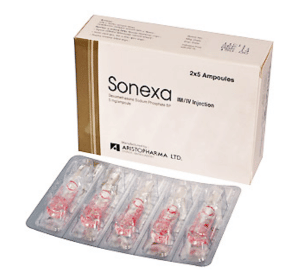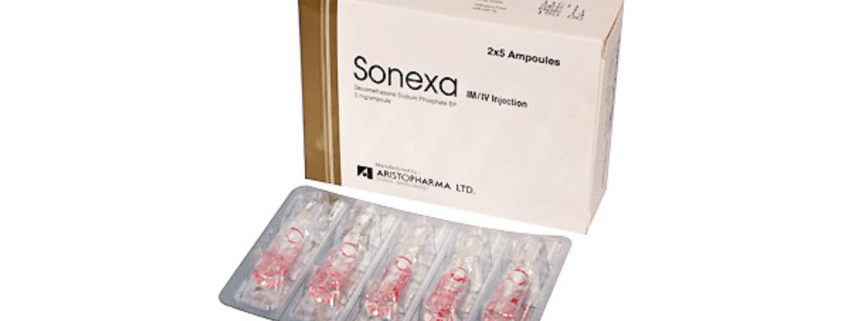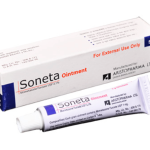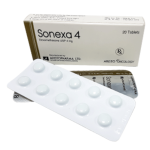Sonexa (Dexamethasone)

Therapeutic Group : Steroid
Presentation:
Each Ampoule (1ml) contains Dexamethasone Sodium Phosphate USP 5 mg (equivalent to Dexamethasone USP 3.5 mg).
Indications:
1. Rheumatoid arthritis
2. Collagen diseases
3. Inflammatory & allergic disorders
4. Anaphylactic shock
5. Cerebral oedema
6. Nausea & vomiting with chemotherapy
7. Acute adrenocortical insufficiency
8. Urticaria
9. Eczema
10. Skin diseases
11. Hyperplasia & hyperpyrexia
12. Gout
Dosage & Administration:
Dexamethasone Sodium Phosphate can be given parenterally at doses of 0.5-20 mg daily either as a single (slow) intravenous or intramascular injection or by intravenous infusion.
Large intravenous doses should be administered slowly to reduce the risk of cardiovascular collapse. The total daily intake of Dexamethasone, even in acute conditions should not exceed 80 mg except in certain very special circumstances.
Cerebral oedema: 10 mg initially by intravenous injection, then 4 mg by intramascular injection every 6 hours is required for 2-10 days.
Shock: By intravenous or intramascular injection or infusion 2-6 mg/kg, repeated if necessary after 2-6 hours.
The dose in children varies from 0.03 to 0.09 mg per kg body weight twice a day for adrenal suppression and between 0.01 mg per kg body weight once a day for other indications. An alternate-day regimen reduces the risk of growth retardation.
Contrainidications:
Ocular herpes simplex is an example of absolute contraindication to corticosteroid therapy. Relative contraindications are:
Gastrointestinal ulcer, acute or chronic infections, osteoporosis, pregnancy, diabetes mellitus, renal insufficiency, hypertension, history of psychotic illness, immediate before prophylactic immunization and finally hypersensitivity to Dexamethasone.
Warning & Precautions:
Dexamethasone should be used with caution in the presence of congestive heart failure or hypertension, in patients with diabetes mellitus, epilepsy, glaucoma, infectious disease, chronic renal failure and uraemia and in elderly persons.
Side effects:
Hypersensitivity including anaphylaxis and allergic skin reactions has been reported. The incidence of predictable undesirable effects of glucocoticoids correlates with the dosage timing of administration and duration of treatment. Patients on prolonged Dexamethasone therapy are at risk of collapse and possibly death if their daily dose is not increased at times of severe physical stress e.g. injury, surgery or infections. The somatic manifestations include growth retardation in children, osteoporosis and aseptic bone necrosis, peptic ulceration, ocular hypertension, subcapsular cataract, pancreatic disturbances and myopathy. Other Cushing-like features characteristic of glucocorticoid excess includes truncal obesity, moon-face, oedema, delayed wound healing, glaucoma and various psychiatric syndromes. These are all generally reversible with discontinuation of Dexamethasone treatment.
Drug interaction:
Dexamethasone exhibits interaction with phenytoin and phenobarbitone, ephedrine, rifampicin, magnesium trisilicate, salicylate, potassium depleting diuretics (such as thiazide or frusemide), cardiac glycosides, NSAIDs, anticoagulants, antidiabetics, antihypertensives, barbiturates, carbamazapine, primidone, antimuscarinic agents.



